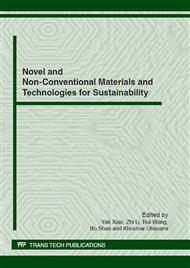[1]
Subyako, Bambang Subiyanto, Sandra A Azis, Cultivation and utilization of bamboo in Indonesia, Journal of Bamboo Research. 16 (1997) 1-7.
Google Scholar
[2]
Yuhe Deng et al, Effect of buffes on gypsum particleboard properties, Journal of Wood Science. 47 (2001) 356-361.
Google Scholar
[3]
Qisheng Zhang, Fengwen Sun, Bamboo-wood composite container floor, China Forestry Science and Technology. 6 (1997) 23-25.
Google Scholar
[4]
Qisheng Zhang, Fengwen Sun, Bamboo-wood composite hollow board, China Forestry Products Industry. 24 (1997) 6-9.
Google Scholar
[5]
Zhangkang Wu, Hongjian Zhang et al, Effects of manufacturing technology on properties of MDF from bamboo and wood, China Wood Industry. 14 (2000) 7-10.
Google Scholar
[6]
Jun Qian, Liangming Ye, Yongming Jin, fast growing fir and bamboo yellow strip composite board, Building Artificial Board. 2 (1999) 35-37.
Google Scholar
[7]
Paolo Feraboli, Notched response of OSB wood composites, Composites: Part A. 39 (2008) 1355-1361.
DOI: 10.1016/j.compositesa.2008.04.017
Google Scholar
[8]
Brumbaugh J, Effect of flake dimension on properties of particleboard, Forest Products Journal. 10 (1960) 243-6.
Google Scholar
[9]
Brochmann J, Edwardson C, Shmulsky R, Influence of resin type and flake thickness on properties of OSB, Forest Products Journal. 54 (2004) 51-5.
Google Scholar
[10]
Suzuki S, Takeda K, Production and properties of Japanese oriented strand board I: effect of strand length and orientation on strength properties of sugi oriented strand board, Journal of Wood Science. 46 (2000) 289-95.
DOI: 10.1007/bf00766219
Google Scholar
[11]
Ihak Sumardi · Kazuhiro Ono · Shigehiko Suzuki, J Wood Science, 53 (2007) 510-515.
Google Scholar
[12]
Pannipa Malanit · Marius C, Barbu · Arno Frühwald, Physical and mechanical properties of oriented strand lumber made from an Asian bamboo, Eur. J. wood product. 69 (2011) : 27-36.
DOI: 10.1007/s00107-009-0394-1
Google Scholar
[13]
Mingjie Guan, hygrothermal effects of wood-bamboo composite, Nanjing Forestry University. (2006).
Google Scholar
[14]
Yunling Zhang, Recovery of compressed paulownia wood fixed with low molecular weight water-soluble melamine-formaldehyde resin, China Wood industry. 10 (1996) 15-18.
Google Scholar
[15]
Guangrui Sun, Study on spingback of particleboard mat after prepressing, China Wood Industry. 11 (1997) 8-1.
Google Scholar
[16]
Jiyou Gu, Zhenhua Gao, Hanyan Tan, Jun Ai, study on production technology of particleboard with isocyanate resin, Wood Industry. 13 (1999) 7-23.
Google Scholar
[17]
Zhikun Liu, Nana Hu, Research on manufacture technology of bamboo/wood composite oriented strands lumber, China Forest Products Industry. 34 (2007) 26-29.
Google Scholar
[18]
Ling Liu, Mingkun Lu et al, Effects of porosity on the ultrasonic absorption coefficient and mechanical strength of carbon/epoxy composite, Acta material compositae sinica. 21 (2004) 116-121.
Google Scholar
[19]
Chong Jia, Yang Zhang et al, study on manufacture of rice straw board reinforced with bamboo material, China Forest Products Industry. 36 (2009) 34-37.
Google Scholar
[20]
Mingkai Peng, Changtong Mei, Effects of strand geometry and orientation on the properties of laminated strand lumber, Journal of Nanjing Forestry University (Natural Sciences Edition) 33 (2009) 129-131.
Google Scholar


